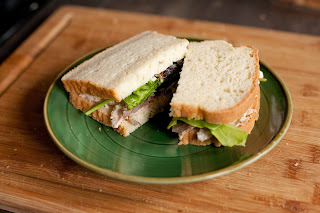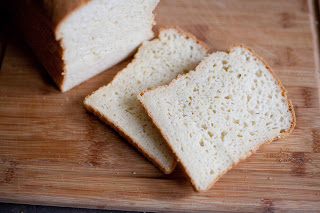King Arthur Flour Gluten-free Bread Mix Review
I have to confess that I'm not very good at following directions. In fact, I almost never cook anything exactly as instructed, and I am pretty savvy about when and where to skip steps or make substitutions. When I saw that the King Arthur Gluten-free Bread Mix called for three eggs I was tempted to change the recipe entirely, but I was afraid that if it didn't turn out I wouldn't be able to legitimately review it. So I started off to make the bread as directed.
I threw in the three eggs, warm water, and 4 Tbsp of walnut oil. I mixed with an electric mixer as instructed. I added the flour one cup at a time. Somehow, in the middle of it all, my subconscious took over and I ended up doing things my own way by sheer force of habit. Sure, I added the three eggs, but I skipped another step entirely. And it still came out.
I've been making a lot of gluten-free bread recently, and I've figured out that you can completely skip the second rise with GF breads. In fact, it can improve your bread to skip that second rise. Gluten-free dough often isn't resilient enough to come back completely from being punched down, so I simply don't do it. It shaves quite a bit of time off making a loaf. Besides, the whole purpose of knocking down the dough and stirring or kneading a second time is to make sure your yeast is evenly distributed throughout the dough. If you've made most gluten-free breads by their instructions, you've already beaten the heck out of it, so your yeast distribution has already been taken care of.
This bread rose higher than any gluten-free bread I've baked. I let it rise for about 45 minutes, which is when most GF breads I've made have maxed out. This loaf even kept rising in the oven, which I haven't been able to get other GF breads to do. When it came out after 50 minutes of cooking, the top was nicely rounded and browned.
The instructions say to let it cool on a rack before cutting, but it didn't say for how long. I was semi-patient, and let it cool for about 25 minutes before enjoying a warm slice. It had a nice, resilient texture and the bread holds together better than most GF breads, making it ideal for sandwiches. With all the eggs and oil, the dough comes out fairly rich, but it's not as dense as most GF breads I've tried. Where flavor is concerned, however, I am afraid that the King Arthur bread mix is a little lacking. It's great as a substitute for white sandwich bread, but as a slice of bread to be eaten on its own with a nice slab of butter, you might go for something else. Would letting the dough rise a second time have given it more of a traditional yeasty flavor? I doubt it, but perhaps next time I'll be more patient. (See the comments below for more discussion on this topic.) Knowing how well it rose I might trust it to spring back from a knocking down. Knowing me, however, I'll probably be tempted to change something else - I just can't help it.
The King Arthur Gluten-free Bread Mix is mostly a blend of rice flour, tapioca flour, and potato starch. This blend of flours is great for giving the dough elasticity and the bread lift, but none of these flours has a lot of flavor. The mix also has emulsifiers and xanthan gum for texture and elasticity. The box comes with its own yeast packet. King Arthur has done a very good job at developing a very neutral bread product that keeps well and will be very practical for sandwiches. However, I have to wonder what a little sorghum flour would do to the bread for adding flavor and substance. I might try adding a pinch more sugar, salt, and yeast for flavor and see if that affects how it rises.
Have you tried King Arthur Gluten-free Bread Mix? What did you think? I'd love to hear what you have to say!
I threw in the three eggs, warm water, and 4 Tbsp of walnut oil. I mixed with an electric mixer as instructed. I added the flour one cup at a time. Somehow, in the middle of it all, my subconscious took over and I ended up doing things my own way by sheer force of habit. Sure, I added the three eggs, but I skipped another step entirely. And it still came out.
I've been making a lot of gluten-free bread recently, and I've figured out that you can completely skip the second rise with GF breads. In fact, it can improve your bread to skip that second rise. Gluten-free dough often isn't resilient enough to come back completely from being punched down, so I simply don't do it. It shaves quite a bit of time off making a loaf. Besides, the whole purpose of knocking down the dough and stirring or kneading a second time is to make sure your yeast is evenly distributed throughout the dough. If you've made most gluten-free breads by their instructions, you've already beaten the heck out of it, so your yeast distribution has already been taken care of.
This bread rose higher than any gluten-free bread I've baked. I let it rise for about 45 minutes, which is when most GF breads I've made have maxed out. This loaf even kept rising in the oven, which I haven't been able to get other GF breads to do. When it came out after 50 minutes of cooking, the top was nicely rounded and browned.
The instructions say to let it cool on a rack before cutting, but it didn't say for how long. I was semi-patient, and let it cool for about 25 minutes before enjoying a warm slice. It had a nice, resilient texture and the bread holds together better than most GF breads, making it ideal for sandwiches. With all the eggs and oil, the dough comes out fairly rich, but it's not as dense as most GF breads I've tried. Where flavor is concerned, however, I am afraid that the King Arthur bread mix is a little lacking. It's great as a substitute for white sandwich bread, but as a slice of bread to be eaten on its own with a nice slab of butter, you might go for something else. Would letting the dough rise a second time have given it more of a traditional yeasty flavor? I doubt it, but perhaps next time I'll be more patient. (See the comments below for more discussion on this topic.) Knowing how well it rose I might trust it to spring back from a knocking down. Knowing me, however, I'll probably be tempted to change something else - I just can't help it.
The King Arthur Gluten-free Bread Mix is mostly a blend of rice flour, tapioca flour, and potato starch. This blend of flours is great for giving the dough elasticity and the bread lift, but none of these flours has a lot of flavor. The mix also has emulsifiers and xanthan gum for texture and elasticity. The box comes with its own yeast packet. King Arthur has done a very good job at developing a very neutral bread product that keeps well and will be very practical for sandwiches. However, I have to wonder what a little sorghum flour would do to the bread for adding flavor and substance. I might try adding a pinch more sugar, salt, and yeast for flavor and see if that affects how it rises.
Have you tried King Arthur Gluten-free Bread Mix? What did you think? I'd love to hear what you have to say!









Comments
Thanks for reading! When I try the bread again, I'll allow for more time to do a second rise and see if the flavor changes. On my own breads I've been able to get a nice, yeasty flavor with only one rise. I was kicking myself because I didn't measure the amount of yeast you provide for the King Arthur Gluten-free Bread mix, but I use one tablespoon per 1 pound of flour. That is about the maximum you can use without ruining the dough, and it's good for a short rise. It's true that the longer you ferment something the more yeast you get, but with GF breads I've found it's easier to just start with more yeast.
Thanks for the tip on the egg substitute. I haven't tried flax meal yet. I don't have a problem with eggs, but three for one loaf is a lot and it does change the texture of the dough. I imagine the protein in the egg gives it more structure, too, and helps the bread to rise.
Thanks for the great comment and information!
I'm glad to hear back from someone else who has tried and liked the King Arthur Gluten-free Bread Mix. I agree that it would be nice to see some more nutritious flours in lots of GF breads, but it's more difficult to get whole-grain flours to rise. This is definitely a white bread. I bet it does make great french toast! Thanks for the comment!
I forgot to mention that the pan came with the mix! Isn't it great? I've been looking for a pan like this for gluten-free bread. It's non-stick, too, so it's easy to clean.
I've found that my hot-water radiators are the perfect temp for rising bread on, and I can set the loaf right on top!
I was just wondering- the bread looks delicious- but is it dry or is it kind of soft? Because mostly bread I have made turns out dry after 4-5 hours... and when you're making sandwiches does it crumbles alot?
Abd on the rare occasions I use a mix, I add something more nutritions, such as whole millet, quinoa flakes, etc.
Thanks for your reviews of Portland area eateries. I live in Corvallis but like to explore new food choices on my trips to the Big City!
Mary Garrard
Gluten Free
after reading the comment from "Allison" from King Arthur I tried using the flaxmeal to replace the eggs in my breads using the KAF GF bread mix... FAIL I have used this mix many times in the past with great results, now I am left with three loaves of bread that are half the hight they should be! I double proof them, and use the special bread pan, everything I should. On the second proof they get to just about the top of the pan then fall in the oven. What a waste of almost $40 in bread mix! :(
mix it whole then blend in mixer. Allsion said 2 TBSp. that could change the texture and binding properties. My 2cents.